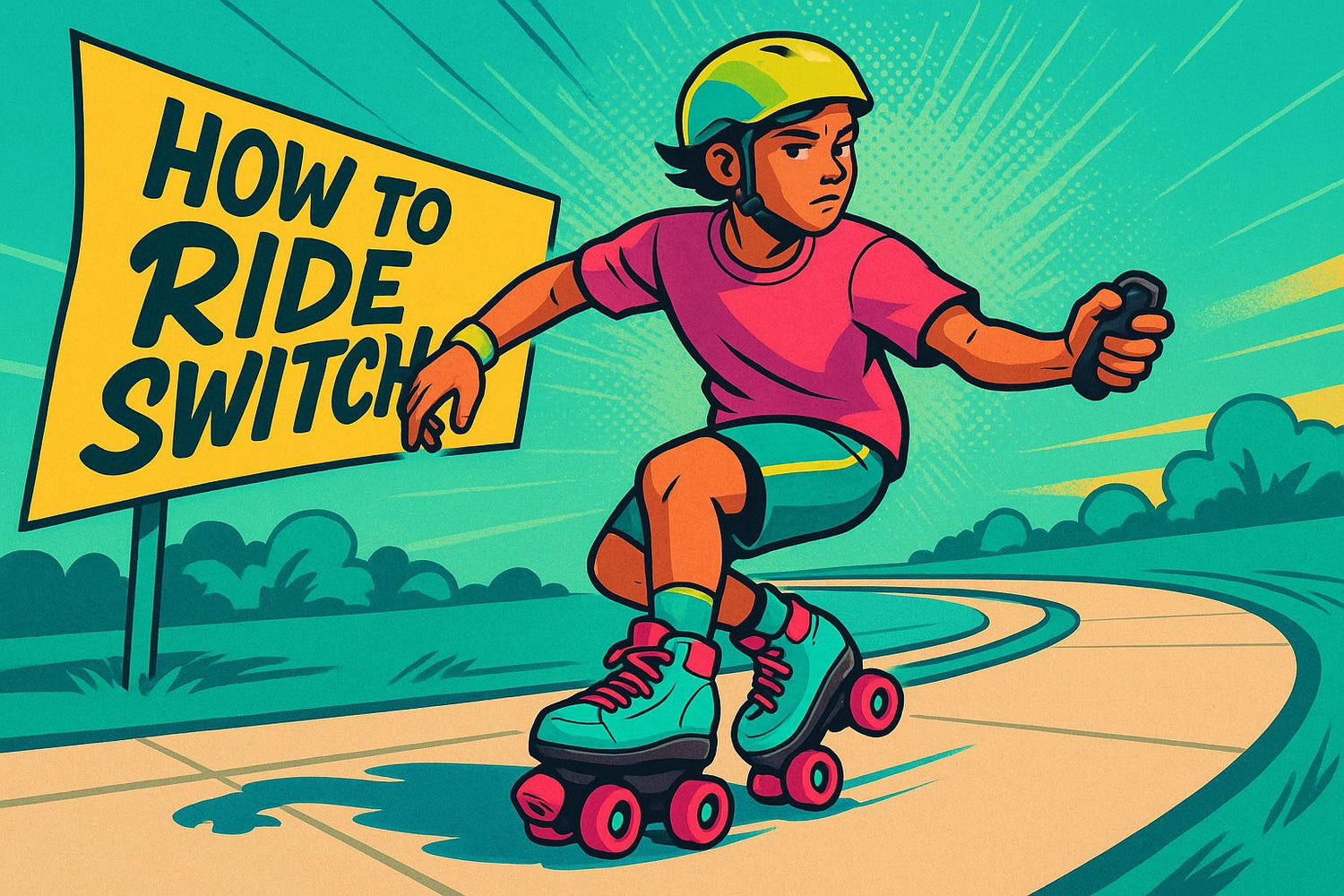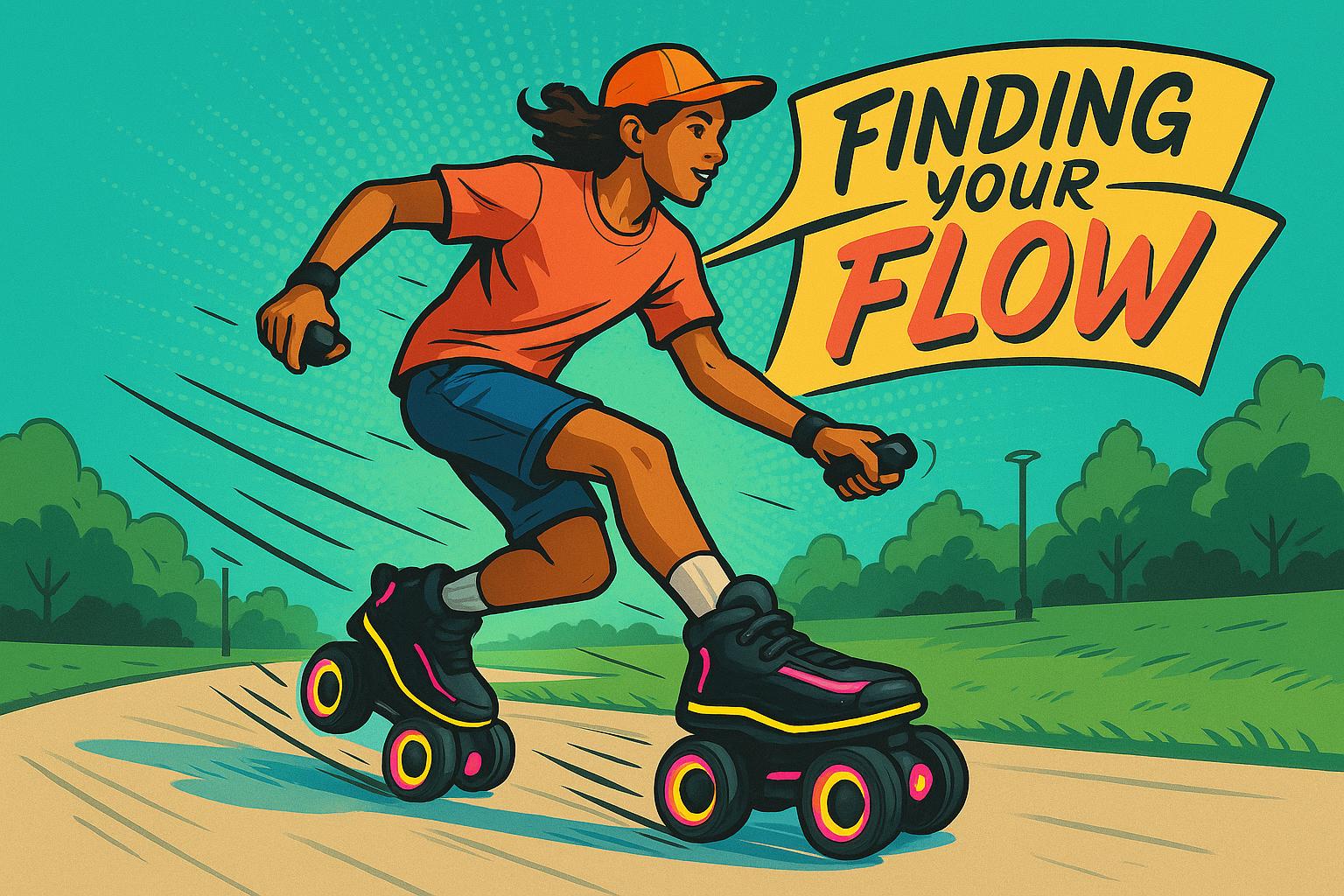Riding switch - leading with your non-dominant foot - can feel awkward at first, but it’s a skill that improves balance, control, and confidence on Wheelfeet skates. By training your weaker side, you’ll handle sharp turns, sudden stops, and tricky maneuvers more smoothly. This guide breaks down everything you need to know, from finding your stance to practicing balance, braking, and turns safely.
Key Takeaways:
- What is switch riding? Skating with your non-dominant foot forward.
- Why learn it? Boosts control, balance, and versatility.
- Getting started: Use protective gear, practice on smooth surfaces, and adjust your skates for comfort.
- Steps to learn: Start with balance drills, progress to slow glides, and practice braking and turns.
With regular practice, you’ll build muscle memory and confidence, unlocking smoother rides and better control in any direction.
Switch Riding and Stance Basics
What Is Switch Riding?
Switch riding is skating with your non-dominant foot leading the way. At first, it might feel awkward - kind of like using your non-dominant hand to write - but with practice, it becomes a skill that can take your skating to the next level.
When you ride switch on your Wheelfeet skates, your body has to adjust to a completely different balance dynamic. Your dominant leg, which usually handles weight shifts and steering from the back, now takes the lead, while your non-dominant leg focuses on stability and control. This shift trains your body to react from a new perspective, improving coordination and sharpening your ability to handle unexpected situations. Over time, this practice helps you develop a better sense of balance and reduces imbalances in your movements.
The payoff? Switch riding makes tricky maneuvers - like sharp turns, dodging obstacles, or changing direction - feel smoother and more natural. It’s a skill that can make your skating more fluid and versatile.
Finding Your Stance: Regular vs. Goofy
Before diving into switch riding, it’s crucial to figure out your natural stance. In skating, this comes down to two options: regular or goofy. If your left foot leads, you have a regular stance. If your right foot leads, you’re goofy.
Most riders figure out their stance naturally the first time they step onto their Wheelfeet skates. Your body will instinctively find the position that feels most balanced and comfortable. If you’re unsure, pay attention to which foot you lead with during a slide or when steadying yourself after a gentle push - it’s usually a good indicator.
Once you know your natural stance, switch riding is simply reversing it. Understanding this is key to training effectively. You’ll know which leg might need extra attention to build strength and which movements might feel trickier as you practice. Sure, it might feel as awkward as brushing your teeth with your other hand at first, but that’s exactly why it’s so valuable. Tackling these challenges will improve your overall technique and make you a more confident skater.
With your stance figured out, you’re ready to focus on refining your setup and ensuring your safety as you take on switch riding.
Preparation and Safety Tips for Switch Riding
Switch riding requires thoughtful preparation since it involves stepping out of your comfort zone with a new stance. Taking the right precautions can help you avoid injuries while making the learning process smoother. These measures not only keep you safe but also enhance your ability to ride with greater control.
Using Proper Protective Gear
Switch riding tests your balance and reflexes, which means protective gear is a must. Start with a snug, safety-certified helmet to shield your head from potential impacts. Since falling is part of the learning curve, wrist guards are invaluable - they help absorb the shock when you instinctively try to break a fall with your hands. Knee and elbow pads are also essential to protect your joints, which can take the brunt of a tumble. And if you’re prone to ankle injuries, consider using ankle guards for added stability.
Once you’re geared up, the next step is finding a safe and suitable practice environment.
Choosing the Right Practice Area
Stick to smooth, flat surfaces when practicing switch riding - uneven terrain increases the risk of falls. Avoid areas with traffic, as they can add unnecessary stress and danger while you’re learning. Skate parks can be a great option, especially if you start in flat, open areas before attempting ramps or obstacles. If you prefer an indoor setting, garages or basements with consistent, smooth floors can work well. Practicing during off-peak hours is also a smart move, as it minimizes distractions and obstacles.
Once you’ve secured a safe practice zone, it’s time to fine-tune your skates for the task.
Adjusting Wheelfeet Skates

When it comes to switch riding, having your skates properly adjusted is crucial. Wheelfeet electric roller skates come with adjustable bindings that fit regular shoes sized 6 to 13 US or 38 to 47 EU. Before you begin, ensure the bindings are snug but not overly tight. Choose sports shoes that provide solid ankle support, and tighten the bindings fully to maintain stability and control. Start with the speed set to Low to match your skill level as you ease into switch riding. Test your setup with gentle movements to ensure everything feels secure before switching stances.
Step-by-Step Guide to Switch Riding
With your Wheelfeet skates adjusted and a safe practice area ready, it's time to dive into the switch riding technique. This process will help you ease into the skill, starting with balance and progressing to controlled movement and braking.
Balancing in Switch Stance
Begin by adopting a "mirror stance." If you typically ride with your left foot forward, switch to leading with your right. Keep your head and gaze forward - this alignment helps your body adjust to the new stance more naturally.
To maintain stability, bend your knees and keep your center of gravity low, directly over your skates. Stay relaxed, with your posture slightly athletic, and let your arms move naturally for balance. Experiment with small weight shifts between your feet until you feel steady in this new position. Once you’ve nailed the balance, it’s time to start moving.
Starting with Gentle Pushes and Glides
Set your Wheelfeet skates to their lowest speed using the remote control and begin gliding forward slowly. Focus on maintaining your low center of gravity and keeping your knees bent for better balance.
Take it one step at a time - short, straight-line glides are your best friend here. If you feel unsteady, slow down or pause to recalibrate. This gradual approach helps you build muscle memory for your non-dominant stance. Keep in mind, your non-dominant leg may tire quicker, so don’t hesitate to take breaks as needed.
Building Speed and Practicing Braking
Once you’re comfortable with gentle glides, start increasing your speed gradually. Wheelfeet skates can hit speeds up to 15 mph, but there’s no rush - stick to a pace that feels manageable and safe.
As you pick up speed, practice braking in your switch stance. Wheelfeet's regenerative braking system ensures smooth stops while recharging the battery. When braking, lean back slightly and keep your knees bent to absorb the deceleration. Apply the brakes gradually, staying in your switch stance throughout the process to maintain control and stability.
sbb-itb-bf837b9
Exercises to Build Confidence and Coordination
Switch riding takes practice and specific exercises to sharpen your coordination and build muscle memory. According to research, riders who incorporate balance drills into their routine are 30% less likely to experience falls or loss of control when switching stances compared to those who skip these exercises.
Static Balance Drills
Start with basic balance exercises before introducing movement. Stand in your switch stance on a flat, stable surface, using a wall or sturdy object for support. Keep your weight evenly distributed across both feet and maintain a slight bend in your knees.
Practice shifting your weight from heel to toe and side to side while standing still. This simple drill lays the groundwork for better balance and control. Hold the position for 30–60 seconds at a time, repeating several rounds.
As you gain confidence, reduce your reliance on hand support. Eventually, transition to balancing without any assistance. For an extra challenge, try single-foot balance by lifting one foot at a time. Advanced riders can incorporate gentle rocking motions or even close their eyes briefly to test their stability and proprioception. These variations mimic real riding conditions and prepare you for more dynamic movements.
Slow Rolling Starts and Stops
Once you’ve built a solid foundation with static balance, it’s time to add motion. Set your Wheelfeet skates to their lowest speed and focus on smooth, controlled acceleration from a complete stop. The goal is to maintain your switch stance throughout, resisting the urge to revert to your more comfortable position.
Work on controlled braking using Wheelfeet’s regenerative braking system. Start with short distances - just a few feet - and gradually increase as you become more confident. Keep your knees bent and your center of gravity low during both acceleration and braking to maintain stability.
Repeat short start-and-stop sequences to develop muscle memory and improve your overall control.
Switch Turns and Weight Shifts
After mastering starts and stops, move on to refining your directional control. Begin with gentle S-shaped turns at low speeds, focusing on smoothly transferring your weight from one edge to the other. These serpentine movements help you understand how weight distribution affects your direction in a switch stance.
Set up markers to practice weaving through a zigzag course. Start with wide turns and gradually tighten them as your coordination improves. This exercise helps you develop the precise weight shifts needed for confident maneuvering.
You can also practice isolated weight shifts by riding straight and deliberately moving your weight left and right without turning. This drill helps you grasp the subtle movements that influence direction, setting the stage for more advanced techniques.
Building a Routine
For a balanced practice session, try this 20-minute routine:
- 5 minutes: Static balance drills
- 5 minutes: Slow starts and stops
- 5 minutes: S-shaped turns
- 5 minutes: Combination drills
To see consistent improvement, aim for 15–20 minutes of focused switch stance exercises, 3–4 times per week. Regular practice will help you develop muscle memory, improve your balance, and build confidence. Keep track of your progress by noting how long you can balance, how far you can ride in switch stance, and how smoothly you can perform turns and stops without support.
Common Challenges and Solutions
Learning to ride switch comes with its own set of hurdles, especially for beginners. These obstacles are completely normal and can be tackled with the right mindset and techniques.
Dealing with Balance Issues
When you switch your stance, your body has to adjust to a whole new way of balancing, which can feel awkward at first. Your non-dominant leg suddenly has to take charge of steering and stabilizing, which might leave you feeling unsteady.
To manage this, try experimenting with small weight shifts to regain control quickly. Avoid leaning back, locking your knees, or staring down at your feet. If you start to wobble, extend your arms, bend your knees a bit deeper, and keep your focus ahead. If you stumble, shift your weight back to center and use your hips to realign yourself. Practicing controlled falls on soft surfaces can also teach you how to recover safely. These small adjustments will build on the balance skills you’ve already developed.
Once your balance improves, you’ll likely notice fatigue in your non-dominant leg becoming the next challenge.
Managing Fatigue in the Non-Dominant Leg
Switch riding can be tough on your non-dominant leg since it’s not used to the workload. Muscle fatigue is common, but you can counter it with a mix of rest and conditioning. Take regular breaks to maintain proper form and reduce the risk of falls. Before skating, try dynamic stretches like leg swings or lunges to warm up. Afterward, static stretches like hamstring and calf stretches can help with recovery. Strength-building exercises, such as single-leg squats, calf raises, and balance drills, are also great for evening out muscle strength and improving control. These exercises will complement your earlier slow-rolling and braking practice.
Once you’ve built up strength and endurance, you can start applying these skills to more challenging terrain.
Improving Confidence on Rough Surfaces
Switch riding on uneven or rough surfaces can feel intimidating. Small cracks or bumps might seem more pronounced, making it harder to stay in control. To boost your confidence, start by slowing down your speed and ensuring your wheels are in good condition. Focus on smooth, deliberate movements. Begin practicing on the flattest, smoothest surfaces you can find, and gradually work your way up to rougher terrain. Keeping your eyes forward will help you spot obstacles early and maintain your balance.
Conclusion: Key Takeaways for Riding Switch
Mastering the art of riding switch on your Wheelfeet skates opens up a whole new level of skating versatility. It’s more than just a skill - it’s a way to boost your balance, coordination, and overall control. This added versatility not only makes you a more confident skater but also ensures safer and smoother rides in any scenario.
Preparation is everything. Start with the basics: wear protective gear, find a smooth surface for practice, and make sure your skates are properly adjusted. These small steps set you up for success from the very beginning. By progressing gradually - starting with static balance, moving to gentle glides, and eventually practicing braking - you’ll avoid picking up bad habits and build a solid foundation for switch riding.
The secret to progress lies in consistent, focused practice. Drills like balancing in place, slow rolling starts and stops, and practicing switch turns help train your non-dominant leg and develop the muscle memory needed for better control. Over time, these exercises not only improve your switch skills but also boost your confidence across all aspects of skating.
As you continue practicing, the benefits of switch riding will become clear. It enhances your overall capabilities, making every ride more controlled and enjoyable. Whether you’re weaving through crowded sidewalks, dodging obstacles, or simply giving your dominant leg a break during long sessions, the skills you gain will serve you well throughout your skating journey.
Start small - just a few minutes of switch practice each session - and gradually increase your time as you grow more comfortable. With dedication, you’ll notice improvements in braking, balance, and control, making every ride smoother and more rewarding.
FAQs
What are the most common mistakes beginners make when learning to ride switch, and how can they avoid them?
Beginners often find riding switch challenging because they overlook the importance of balance and posture. This can cause instability or even lead to falls. Another frequent misstep is jumping into it at high speeds or skipping beginner-friendly modes, which makes controlling the skates harder and increases the chance of accidents.
To steer clear of these problems, focus on keeping your weight centered over your skates and start practicing at slower speeds. If your skates offer beginner modes, take advantage of them. You can also try simple balance exercises, like shifting your weight from one foot to the other. Practicing controlled stops is another excellent way to build confidence and sharpen your coordination when riding switch.
How can I tell if I’m getting better at riding switch, and what are the signs of improved balance and control?
You’ll notice progress in riding switch on electric roller skates when you begin to feel steadier and more at ease in the stance. Signs of improvement include smoother transitions between your regular and switch stances, being able to ride switch for longer stretches without losing balance, and handling turns or basic tricks with less effort.
The key to mastering this skill is consistent practice. Try exercises like one-foot glides, gradual 90-degree turns, and balancing drills to sharpen your coordination and stability. With time, riding switch will start to feel more instinctive, requiring less conscious effort to stay in control. These changes are clear indicators that your switch-riding skills are leveling up.
What are the best off-skate exercises to strengthen my non-dominant leg and improve my switch riding skills?
To boost strength and stability in your non-dominant leg for better switch riding, focus on exercises that target balance, coordination, and muscle control. Start with single-leg hops and lateral jumps - these are excellent for building leg strength and stability. Adding side-lying leg raises to your routine can also be beneficial, as they specifically work your hip abductors, which are key for staying balanced while riding.
For improved coordination, include balance drills like standing on one leg for longer durations, or try agility exercises such as ladder drills to enhance footwork. Incorporating plyometric exercises - think jump squats or box jumps - can help develop explosive power and better control. Make these exercises a regular part of your routine, and you'll notice increased confidence and skill when riding switch on your electric roller skates.




Leave a comment
All comments are moderated before being published.
This site is protected by hCaptcha and the hCaptcha Privacy Policy and Terms of Service apply.